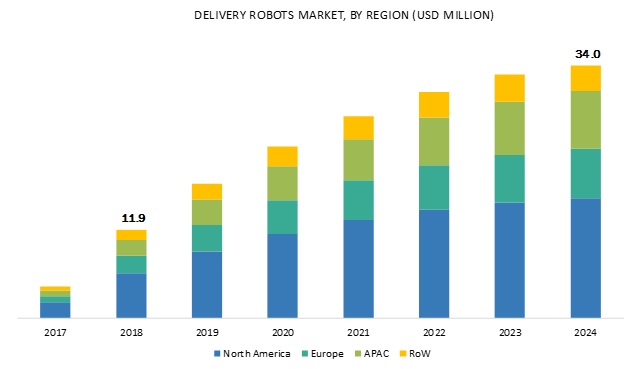According to the new market research report "Delivery Robots Market by Load Carrying Capacity (Up to 10, 10.01-50.00, and More than 50 kg), Component (LiDAR Sensors, Control Systems), Number of Wheels (3, 4, and 6), End-User Industry (Food & Beverages, Retail), and Geography - Global Forecast 2024", The delivery robots market is expected to grow from USD 11.9 million in 2018 to USD 34.0 million by 2024, at a CAGR of 19.15% during the forecast period. Autonomous delivery robots are primarily useful for food & beverages, retail, hospitality, and healthcare industries. Owing to this, the companies developing delivery robots have been receiving funding from venture firms. Another driver for the delivery robots market includes the reduction in last-mile delivery costs.
Download PDF Brochure:-
Key Market Players
A few major companies in the delivery robots market are Starship Technologies (US), JD.com (China), Panasonic System Solutions Asia Pacific (Singapore), Savioke (US), Nuro (US), Amazon Robotics (US), Robby Technologies (US), Boston Dynamics (US), Robomart (US), Eliport (Spain), Dispatch (US), Piaggio Fast Forward (US), Marble (US), TeleRetail (Switzerland), BoxBot (US), and Kiwi Campus (US). Apart from these, players such as House of Battery (US) and Ultralife Corporation (US) supply batteries to key autonomous robot manufacturers, and companies such as Fastree (Switzerland) and Quanergy (US) are the suppliers of light detection and ranging (LiDAR) sensors.
Starship Technologies offers self-driving delivery robots that improve the local distribution of goods and groceries. The company’s vision of zero cost, zero waiting time, and the least adverse impact on the environment have redefined the local delivery chain. The company believes that robots can complete local deliveries within 5–30 minutes from a local hub or retail outlet and with 10–15 times less than the cost of current last-mile delivery alternatives. Robots are overseen by human operators, along with their property to drive autonomously, to ensure safety. The robots developed by the company have covered more than 100,000 miles in more than 100 cities of 20 countries in the world, encountering 15 million people along the way. In June 2018, the company raised the seed capital of USD 25 million, which is likely to be invested in deploying more number of robots in neighborhoods, as well as corporate and university campuses in the US and Europe.
North America to hold a major share of the delivery robots market in 2018
Increasing demand for delivery robots in the retail industry and growing labor charges for last-mile deliveries, drive the delivery robots market growth in North America. Owing to various research programs supported by the government of North American countries, North America is expected to hold the largest share of the delivery robots market in 2018. It has invested millions of dollars in robotics research projects, most of which are defense-related projects. North America has been home to many delivery robot manufacturing companies, such as Robby Technologies (US) and BoxBot (US). Sophisticated and adequate street infrastructure, such as proper design and sufficient width of sidewalks and footpaths, helps companies in testing and operating delivery robots in this region.
Major players in the delivery robots market include Starship Technologies (US), JD.com (China), Panasonic System Solutions Asia Pacific (Singapore), Savioke (US), Nuro (US), Amazon Robotics (US), Robby Technologies (US), Boston Dynamics (US), Robomart (US), Eliport (Spain), Dispatch (US), Piaggio Fast Forward (US), Marble (US), TeleRetail (Switzerland), BoxBot (US), and Kiwi Campus (US).
Get in-depth analysis of the COVID-19 impact on the Delivery Robots Market
Benchmarking the rapid strategy shifts of the Top 100 companies in the Delivery Robots Market
Know More@
About MarketsandMarkets™
MarketsandMarkets™ provides quantified B2B research on 30,000 high growth niche opportunities/threats which will impact 70% to 80% of worldwide companies’ revenues. Currently servicing 7500 customers worldwide including 80% of global Fortune 1000 companies as clients. Almost 75,000 top officers across eight industries worldwide approach MarketsandMarkets™ for their painpoints around revenues decisions.
Our 850 fulltime analyst and SMEs at MarketsandMarkets™ are tracking global high growth markets following the "Growth Engagement Model – GEM". The GEM aims at proactive collaboration with the clients to identify new opportunities, identify most important customers, write "Attack, avoid and defend" strategies, identify sources of incremental revenues for both the company and its competitors. MarketsandMarkets™ now coming up with 1,500 MicroQuadrants (Positioning top players across leaders, emerging companies, innovators, strategic players) annually in high growth emerging segments. MarketsandMarkets™ is determined to benefit more than 10,000 companies this year for their revenue planning and help them take their innovations/disruptions early to the market by providing them research ahead of the curve.
MarketsandMarkets’s flagship competitive intelligence and market research platform, "Knowledgestore" connects over 200,000 markets and entire value chains for deeper understanding of the unmet insights along with market sizing and forecasts of niche markets.
Contact:
Mr. Aashish Mehra
MarketsandMarkets™ INC.
630 Dundee Road
Suite 430
Northbrook, IL 60062
USA : 1-888-600-6441
